 Adam Hocherman, 34, is an entrepreneur and founder of the consumer electronics company American Innovative in Boston, MA. Adam founded the company in 2003 with the help of the US Government’s SBA loan program and is currently the 100% owner. He holds a BS in Mechanical Engineering and an MBA, both from Cornell University. Adam’s writings can be found on his blog at DesignTheatre.net and through his Twitter feed. He welcomes your comments. Read more about sourcing in China here.
Adam Hocherman, 34, is an entrepreneur and founder of the consumer electronics company American Innovative in Boston, MA. Adam founded the company in 2003 with the help of the US Government’s SBA loan program and is currently the 100% owner. He holds a BS in Mechanical Engineering and an MBA, both from Cornell University. Adam’s writings can be found on his blog at DesignTheatre.net and through his Twitter feed. He welcomes your comments. Read more about sourcing in China here.
Part III of the Going It Alone series will answer the question: What is a factory and how can I tell one from another? I will answer the question from a consumer electronics perspective and I will assume an audience that has little or no prior knowledge of manufacturing. The purpose of this article will be to try to introduce the burgeoning entrepreneur to the basic components of electronics manufacturing in China.
I will do this in the context of manufacturing the simple electronic product shown below – a digital kitchen timer that we call the Klip! This is an item that we sell at The Container Store chain and at gourmet stores across the United States. I chose this product because, while relatively simple, it still encompasses all of the major facets (noted in the white boxes) of manufacturing a mass-produced electronic item of greater complexity. I’ll start with a little background, then I’ll give a very basic overview of each manufacturing sub-process and I’ll conclude with a summary that will serve to make your first visit to a third-party manufacturing facility more effective and productive. Armed with the knowledge from this post you should be able to walk into an Asian plant for the first time and have the basic working knowledge that you need to converse intelligently about the creation of your item.
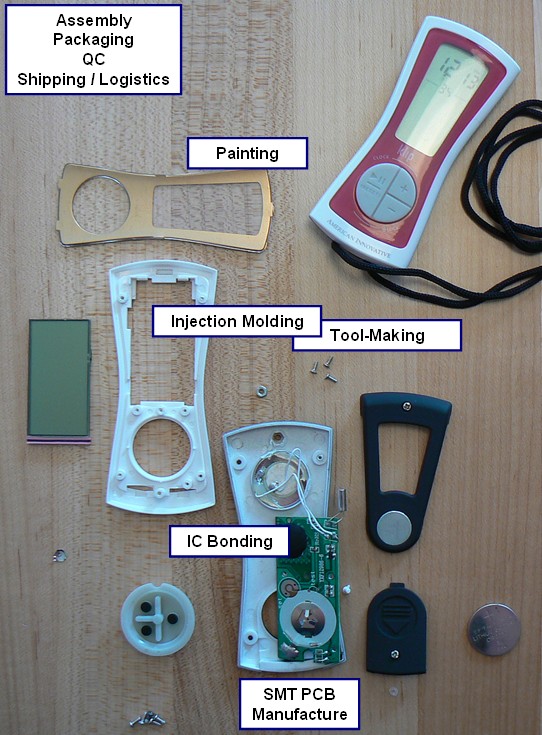
Although the scope of my company’s products is fairly narrow, my personal background in manufacturing is more broad. I have visited upwards of 50 plants both here in the United States and in China which include facilities as diverse as the GE Locomotive factory in Erie, PA to the Dunlop Tire plant in Buffalo, NY to the massive VTech Electronics factory in Asia. I am knowledgeable of lean manufacturing techniques, Poka-Yoke and Kaizan events just to name a few. I mention these subjects only to give you a taste of how deep the topic of manufacturing can get. As someone who is planning to contract with a third-party rather than build a factory of your own, these subjects are more academic in nature than you need to know about for now.
Origins of a Factory
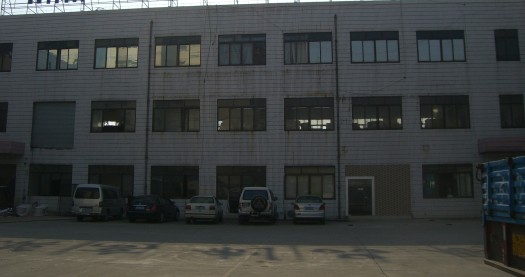
The Exterior of a Plant. While Not Gorgeous to Look At, This Is One of AI’s Best Partners
One of things that I like about working with the factories in China is that big or small, I am typically interfacing directly with the owner and director of the facility. I like these people because they are, like I am, entrepreneurs. I respect these people because as difficult as it is to start and run a company in a country that encourages and embraces capitalistic activities – try doing it in a country like China. Many a long car-ride I have spent trading war stories with these factory owners – one entrepreneur to another. I know that many of you who read my first two posts draw your line between America and China, but I draw it between the entrepreneurs and the corporations. We live in a global economy. These individuals work as hard as anyone I’ve ever met, put people to work and make a life for their employees and their families. To me, that is as honorable a pursuit in China as it is in this country. More on this topic at a later date – for purposes of this article I plan to focus on the mechanics and leave further discussion of the culture for another post.
Assembly
Take a moment to put modern-day electronics in perspective. If you’re under 20 years old, you may feel like inexpensive electronic gadgetry has always been as ubiquitous as it is today. However, I’m 34 and I still remember the mechanical alarm clock that my parents had which displayed digital-like numerals on a series of “leaves” which “flipped” by gravity, as a mechanical gear-train churned away to keep the time. This product predated the advent of the inexpensive, mass-produced integrated circuit (IC) and related display technologies (7-segment LEDs).
Of the factories that American Innovative works with, the oldest ones are a mere 25-30 years old and the youngest one is no older than American Innovative itself – about 7.
Admittedly, the young factory is not as sophisticated as the older factories but, much like the older factories, it began primarily as an assembly house. Over time this factory has (and will continue) to acquire machines and technology that will allow them to bring more and more functions in-house, that are currently performed outside. Perhaps other functions will never be brought in-house. While we tend to view in-house injection molding (see below) as a sign of a more mature facility, we work with at least one very high-quality facility that continues to outsource this, presumably by design.
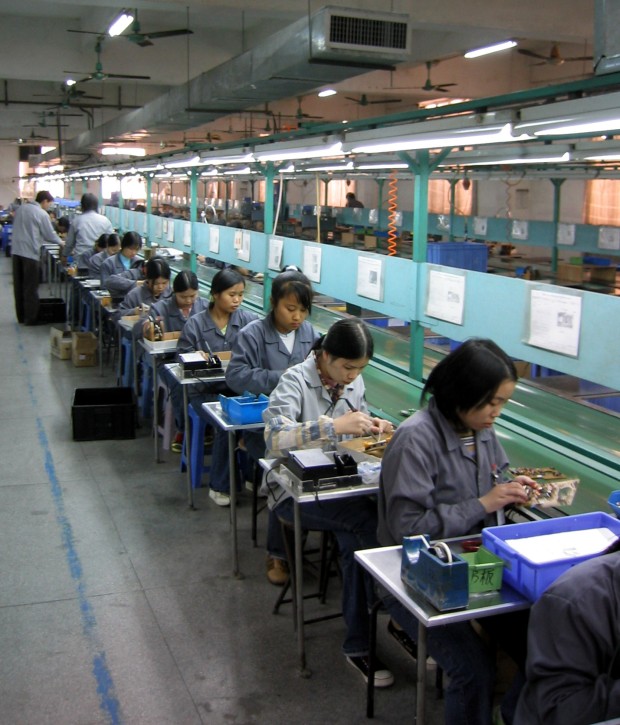
Assembly Line – Notice the instructions behind each worker which outline the detail of that step.
Assembly is what most of you probably think of as the heart of the factory, and it is. All related components have either been acquired from outside sources or manufactured elsewhere in the facility and they come together in long rows of moving conveyor belts and – yes – young, predominantly female, wage-workers which perform a solitary function on the line (more on who these people are in a future post).
The lines are setup such that each worker performs a very specific task, which is carefully planned and designed in advance. The details of that tasks are outlined on a sheet of paper which hangs alongside the station. More recently I’ve seen a more sophisticated setup in which flat screen monitors replace the papers that you observe in the photo here.
A single assembly line step might be to use an electric, torque-limiting screwdriver to secure a PCB (Printed Circuit Board) to a plastic, injection molded base. Another worker might then solder two wire leads to a speaker and a third might be an in-line QC (Quality Control) person which uses a harness to connect power to the partially-built product and test the speaker.
SMT PCB Manufacture
So where does said PCB come from? Printed Circuit Boards are obviously the lifeblood of any electronic product and, not surprisingly, the technology used to create them has come a long, long way. There are two common types of PCB – through-hole and SMT. If you’ve ever assembled a circuit board from a kit using a soldering iron then you’re familiar with through-hole technology. Wire leads from individual components are hand-fed into the PCB (etched previously). The leads are then soldered and snipped. Some components are still done in exactly this manner today but more recently newer, less manual-intensive, technology has replaced this process. SMT stands for Surface-Mount Technology.
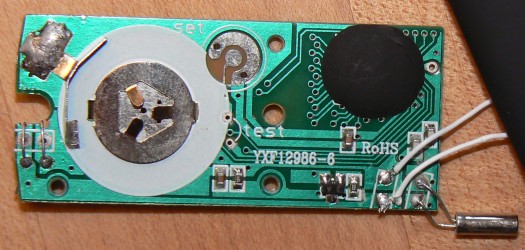
American Innovative Klip! Timer PCB
Look closely at the photo above. This is the PCB that is the core of Americ
an Innovative’s Klip! kitchen timer. The board above is an example of an SMT PCB. On the far right you see a shiny metal cylinder which contains the quartz crystal responsible for running the clock. This is the lone through-hole component on this board. Next to that you can see two white wire leads which run to the speaker. There are a couple of wire jumpers and the battery contacts on the left but other than that the remaining components are surface-mount technology. The small, rectangular boxes are various resistors, transistors or diodes which comprise the circuit.
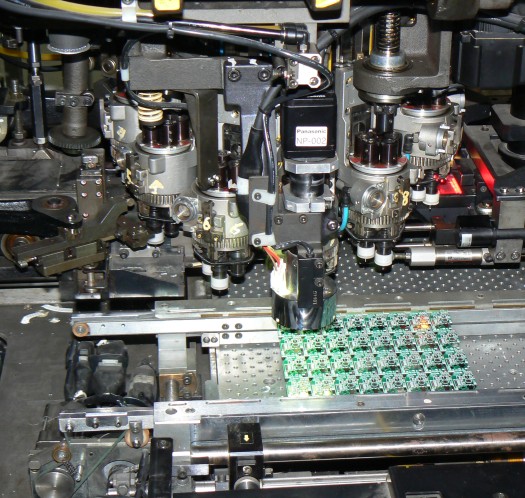
SMT Machine – Notice that many small PCBs are being assembled all at once. They are later separated.
These special SMT components are placed on the PCB using a machine which literally grabs the components one at a time and places them on the board using a guided positioning system or in some older machines I’ve seen (like the one picture at right) by moving the PCB itself around, with the feed mechanism stationary. As an aside, I’ve even been to a factory that makes these machines – there happens to be one in upstate New York. If you ever wanted to know what the machine is that makes the machines that make the machines? Well … it’s us.
There are countless videos on YouTube that will allow you to see an SMT machine in action. Here’s one that I located randomly. Next the boards are run through a machine called a wave solderer that essentially solders every lead all at once, thereby replacing the extensive manual labor that used to go into the creation of a similar board made using through-hole technology. The SMT boards are smaller and more reliable.
IC Bonding
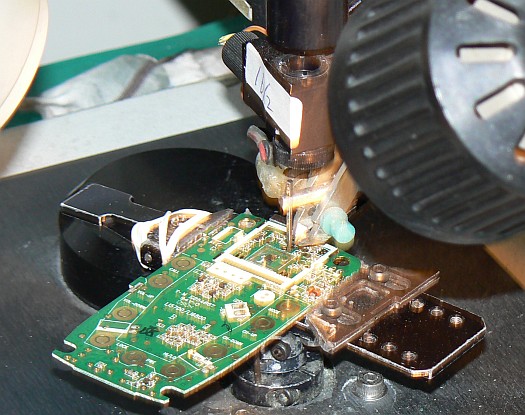
IC Bonding Machine in Action – The Finished Item Will Be a Walkie-Talkie
Looking at the photo of the PCB again, you’ll notice that I haven’t mentioned anything about what that ubiquitous little black blob is. That is a blob of epoxy. Beneath the epoxy is the board’s MCU (Micro Controller Unit). The MCU is “stitched” to the board in a process that looks not unlike sewing with a sewing machine. A worker aligns the IC bonding machine with the receiving area of the PCB using a high-power digital magnifier and then the rest of the process is completely automated. Finally a blob of epoxy covers the delicate MCU pins to prevent damage and deterioration.
Look for the second half of Adam Hocherman’s Going it Alone, Part III tomorrow.